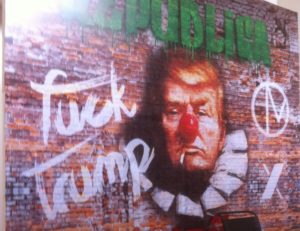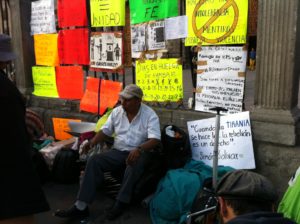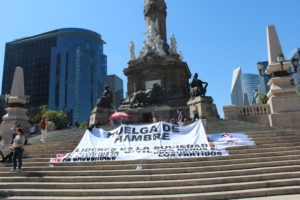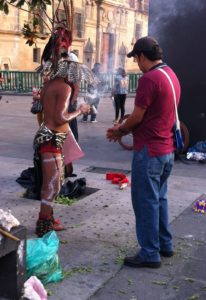In the lobby of the World Trade Centre four leading Mexican furniture companies have built a brick wall with the face of Donald Trump looking down on vistors – portrayed with orange hair, a clown’s red nose and a cigarette hanging from his mouth. To the left is the terse graffiti “Fuck Trump”.
This is the entranceway to an International furniture Show, in the third week of January. Trump’s inauguration will take place during the event.
“For businesses in Mexico, just ten hours to the frontier, the USA is an easy export market. Perhaps because of that we have tended to neglect other opportunities,” explains Roberto Martinez, the man behind the concept of the wall and its message, “we have to not put all our eggs in one basket.”

Mexico is America’s third-largest trading partner, after Canada and China, with about $531 billion in two-way trade in 2015. 80% of Mexican exports are headed to the USA.
“I don’t want to seem arrogant, but we have everything we need here in Mexico – creative design, good communications, great raw materials, craftsmanship, we can sell to Europe and to China’s middle classes.”
“Donald Trump is a businessman, not a politician” explained Carlos Diez of Taller X, one of the companies sponsoring the wall. “It is not so much what he says as the manner in which he says it.”
“Mexico has a lot of potential, we are hard-working, very innovative, and have historic skills and craftsmanship. If they shut down the Maquiladoras [tariff free sewing and assembly plants set up by US companies close to the border to take advantage of lower Mexican labour costs] we can establish our own industry.”

The Editor of Mueble Equipo, a magazine for the Mexican furniture industry, struck a less optimistic note. “It is true enough that if the US government suspends the Free Trade Agreement, and seeks to obstruct the commercial relationship between the two countries, we can look for new friends,” says Juan Manuel Reyes, “but that will take time. A simpler solution would be to look towards the local market. There are uncertain and possibly difficult times ahead. It is a pity we did not start thinking about the future earlier.”
Hein Wulfert, another Mexican furniture maker, estimated that only 30 of the 400 exhibitors at the Show were Mexican exporters.
“Mexico exports avocados and limes. We also export labour, and manufacture low priced products here for outside brands – there is not much added value.”
“The best thing we can do is evolve in specialised industries, like aeronautics. It is important that we export more in order to grow. “
In the weeks leading up to the show, Donald Trump had criticised car manufacturers Chrysler and Ford for manufacturing in Mexico, and threatened General Motors and Fiat-Toyota with “big border taxes” if they went ahead with plans for a new car plant in Mexico. For Hein, this was not a serious threat.
“Donald Trump is talking a lot, but the US consumers will not be willing to pay more. It is more a psychological impact, he wants people to see he is bringing back jobs.”
That was on the Monday. On Tuesday, local newspapers carried the announcement that BMW had confirmed plans to build a $1 billion plant in San Luis Potosi, Mexico, despite a Trump tweet threatening a 35% tax on imports to the USA from it.

Then on Wednesday, Mexico’s front page news came from Switzerland. “Nobody would win a trade war” was the headline, from Chinese President Xi Jinping’s address to the World Economic Forum in Davos. “To follow the path of Protectionism is to enclose yourself in a dark room. For sure you avoid the wind and the rain, but also the light and the air.”
The day after the Presidential inauguration, a few hundred US citizens gathered outside the US embassy in Mexico City to protest Donald Trump’s attitude to immigrants, women and human rights, amongst other issues. In the Zocalo, the historic main square, and below the statue of El Angel, the winged victory Monument of Independence on the Paseo de la Reforma, hunger strikers were protesting the gasolinazo, the price hike.
Across the city, in The Banamex Centre next to Mexico City’s racecourse, the Hippodromo, traders at a gift show were doing good business as shops planned their new lines. “We have two people here just to take orders and when the show is busy they are working all the time,” according to Sales Manager Sarah Lina of Top Gifts. “We had a queue of buyers here on opening.”
Looking to the year ahead, Sarah was less confident about prospects.
“The economy is very unstable, because of all the changes that are happening, because of Trump, the falling peso and the fuel price. It will affect all parts of the economy. Most of our products are imported, nearly all sourced in China. We have to buy in dollars. We expect to put our prices up this year.”
For importers, the value of the peso is challenging. Already trending downward during 2016, the Mexican currency dropped 15% overnight when Trump won the election.

“The fall in the peso affects us but we will get through it,” explains Michelle Ramirez of Aurora, in front of a floor to ceiling display of over 700 different soft toys. “We have a good reputation for quality, we are not selling on price.”
For Mexican consumers, the hike in petrol prices at the end of December was a shock. Car gasoline prices were raised by the government by around 20%, or from 15 to 18 pesos depending on fuel grade. There was a wave of violent protest across the country, which, two weeks later, has largely quietened to peaceful demonstrations.
In the long term, the fuel price rise is designed to rectify historic market imbalances, but to the people on the street, it feels an abusive imposition.
“We are being asked to pay first world prices for our fuel” show visitor Pedro Ruiz told me, “but we are paid third world wages. In the US they pay 12 pesos per litre, and here they want us to pay 16 pesos per litre.”
“They have to do this because they invited foreign companies to invest in oil refining here – Pemex [the state oil company] can not refine sufficient volume, and in any case it operates at a loss.”
Looking beyond the currency and price hike issues, the prospects for Mexico overall are still strong. The World Bank and the Organisation of Economic Cooperation and Development (OECD) are predicting growth for the country in 2017 of 1.8% and 2.3% respectively. These figures are somewhat less than was expected six months ago, but Mexico remains one of the countries in South and Central America still growing, unlike Brazil, the other big regional economy.
Whilst much of the event was a testament to the global free trade in gifts and accessories, there are losers In Mexico as elsewhere. Laura Macias makes cast bronzes, or resin sculptur es, all hand made.
“This fair has been going for 20 years, and originally it was local producers and manufacturers. We have a lot of hand made traditional crafts in Mexico, but it has been very difficult for us to compete with imports,” she said.

“In the past we have sold to the USA, Venezuela, Canada, Colombia, Italy, France, and New Zealand. We can still compete on price with the imports, but we can’t maintain a large stock.”
Rodrigo Ballesteros manufactures painted statuettes of saints and angels in resin and fibreglass – from 20cm tall to almost life-size.
“We used to export all over – Puerto Rico, Portugal, Managua, but we stopped because of the transportation costs, and the difficulties of dealing with trade rules in Mexico,” explains Rodrigo. “For example, we had good exports from here to the USA but after the World Trade Centre attack of 9-11, our exports from here to the USA were effectively stopped.”

“The recent fall of the peso recently benefits us, and it is a great opportunity for us to expand our exports. But it involves a lot of paperwork.”
“We have already lost our shoe industry to cheap imports,” explains Roberto Martinez. “There were trade restrictions but cheap footwear flooded the market anyway. Our textile industry has gone too.”
“Most of our products are imported, because now, there is very little textile industry left here,” Says Jose Cobo, Commercial Manager of accessories chain Eva. “Basically we import from India and China, but India is decreasing.”
“I was at a Fair once when the Gulf War started,” says Laura Macias. ” No-one could sell anything, people were watching the TV screens all round the show. That is what it feels like today. It should be getting easier for us as the peso drops, but there is too much uncertainty, so people are not buying.”
